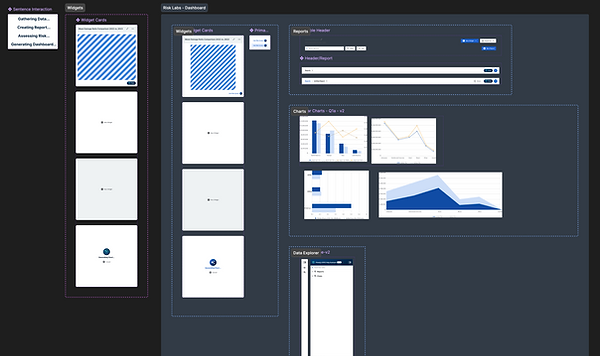


IRP Navigator—a 24/7 AI-powered assistant
My role
I played a key role in shaping the user experience of IRP Navigator from early concept through to launch. I facilitated exploratory design discussions, created prototypes to demonstrate potential interaction patterns, and worked closely with product managers, engineers, and GenAI specialists to align on user needs and technical feasibility.
I contributed to defining the Navigator’s key interaction flows and UI components within the IRP applications, ensuring consistency with our platform design language.
I also collaborated with our customer success and research teams to uncover common pain points and use cases, integrating insights directly into the user journey.
Problem
Our team identified a growing challenge: the rapid pace of product innovation and documentation updates made it hard for users to keep up and self-serve effectively. Language barriers, documentation overload, and delays in customer support often disrupted workflows.
Process
I kicked off with user journey mapping, persona alignment, and documentation analysis. Key steps in our process:
-
Synthesized insights from customer interviews, support logs, and internal stakeholder sessions
-
Explored multiple chat UI patterns to ensure scalability across products
-
Iterated on interaction flows to balance simplicity with technical depth
Outcome
The result was the IRP Navigator—an always-on, conversational GenAI tool embedded within the IRP ecosystem to provide intelligent guidance across documentation, models, workflows, and support pathways.
Design Solution
Defined key interaction flows and UI components within the IRP ecosystem, aligning with platform design standards.
Embedded, In-App Support
-
The Navigator lives inside IRP applications, reducing context-switching and giving users help right where they need it
Cited, Searchable Sources
-
Every response includes clear documentation links, empowering users to explore more deeply
Learning-Focused
-
Beyond reactive help, the Navigator serves as an educational tool to guide users through new or complex tasks
Impact & Success Metrics
IRP Navigator has delivered measurable value since launch:
Higher Engagement
-
Increased in-app usage of features due to improved discoverability
Improved Productivity
-
Minimized workflow disruptions, especially in time-sensitive modeling and analysis scenarios
DISCOVERY
Business Need:
What is IRP Navigator—a 24/7 AI-powered assistant ?
IRP Navigator—a 24/7 AI-powered assistant is natural language generation (NGL), persona agnostic report bot on the Risk Intelligence Platform available across all the platform’s applications. Report IQ will convert exposure and loss analytics into natural language, which can be directly embedded within a dashboard and to be used to deliver critical insights to more people within an organization quickly.
Why do our customers need IRP Navigator—a 24/7 AI-powered assistant?
Today it’s very costly the amount of time invested in resources and collating data to proactively make capital decisions. It’s time consuming and difficult to answer questions without relying on intermediaries to run queries to extract data into the format required to feed into internal planning reports.



HMW Data Handling






FURTHER UNDERSTANDING
User Journey and Early
Sketches


Information Architecture and its visualization
IDEATE
Exploring Different UI For Different Usecases
To support multiple future workflows, I explored different layout scenarios for IRP Navigator. One key initiative was to introduce Risk Labs — a dedicated space for Risk Projects (IRP) and related GenAI interactions.
I also designed the In-App Risk Query experience and integrated Underwriter Assistant workflows to ensure cross-app usability in ExposureIQ, TreatyIQ, and UnderwriteIQ.
DEMO 1: Risk Lab - v3.1
Final iteration of Risk Labs with consolidated app tiles, embedded GenAI entry points, and a clean UI for cross-navigation.
Iterated through:
➜ Risk Labs - v3.0
➜ Risk Labs - v2.0
➜ Risk Labs - v1.0
DEMO 2: Risk Query In-App v1.1
Designed lightweight, embedded Risk Query workflow to allow users to initiate contextual GenAI conversations directly within core IRP applications.
This solution reduced context-switching and supported high-priority user tasks without leaving their workspace.
DEMO 3: Underwriter Assistant
Created a generalized workflow that enabled AI-powered assistance across all IRP applications.
Key focus:
Scalability and shared logic across ExposureIQ, TreatyIQ, and UnderwriteIQ—tailored per app without redundant components.
DECISION
✅ Final Layout (Delivered)
After testing several interaction models:
Whole Interaction Highlights:
-
Unified Risk Lab entry points across tiles and sidebars
-
In-app query launch from any screen for seamless workflow integration
OUTCOME
How I Contribute to Design
System

To support this project, I built a dedicated Generative AI Local Library as a branch of our platform design system. This ensured scalable, production-ready patterns for GenAI elements across IRP apps.

Design System Panel 1
-
I documented and systematized layout logic, tile interactions, embedded GenAI triggers, and microinteractions
-
I created reusable components for launchpad tiles, hover states, badges, and iconography

Design System Panel 2
-
I designed content modules, widget variations, and search/filter logic to support Risk Labs and Underwriter Assistant workflows
-
I focused on flexibility, localization, and alignment with IRP visual standards

Design System Panel 3
-
I built data visualization templates for GenAI-driven insights, including chart containers, result states, and expandable cards
-
I ensured responsive behavior and accessibility compliance across use cases
FINAL REFLECTION
Final Outcome & Impact
We shipped it
The result was IRP Navigator — an always-on, AI-powered assistant embedded into the IRP ecosystem. It provides intelligent, contextual support across documentation, models, workflows, and product surfaces.
IRP Navigator delivered measurable business value:
-
Higher Engagement
→ Increased in-app usage of features due to improved discoverability
-
Improved Productivity
→ Minimized workflow disruptions, especially in time-sensitive modeling and analysis scenarios





